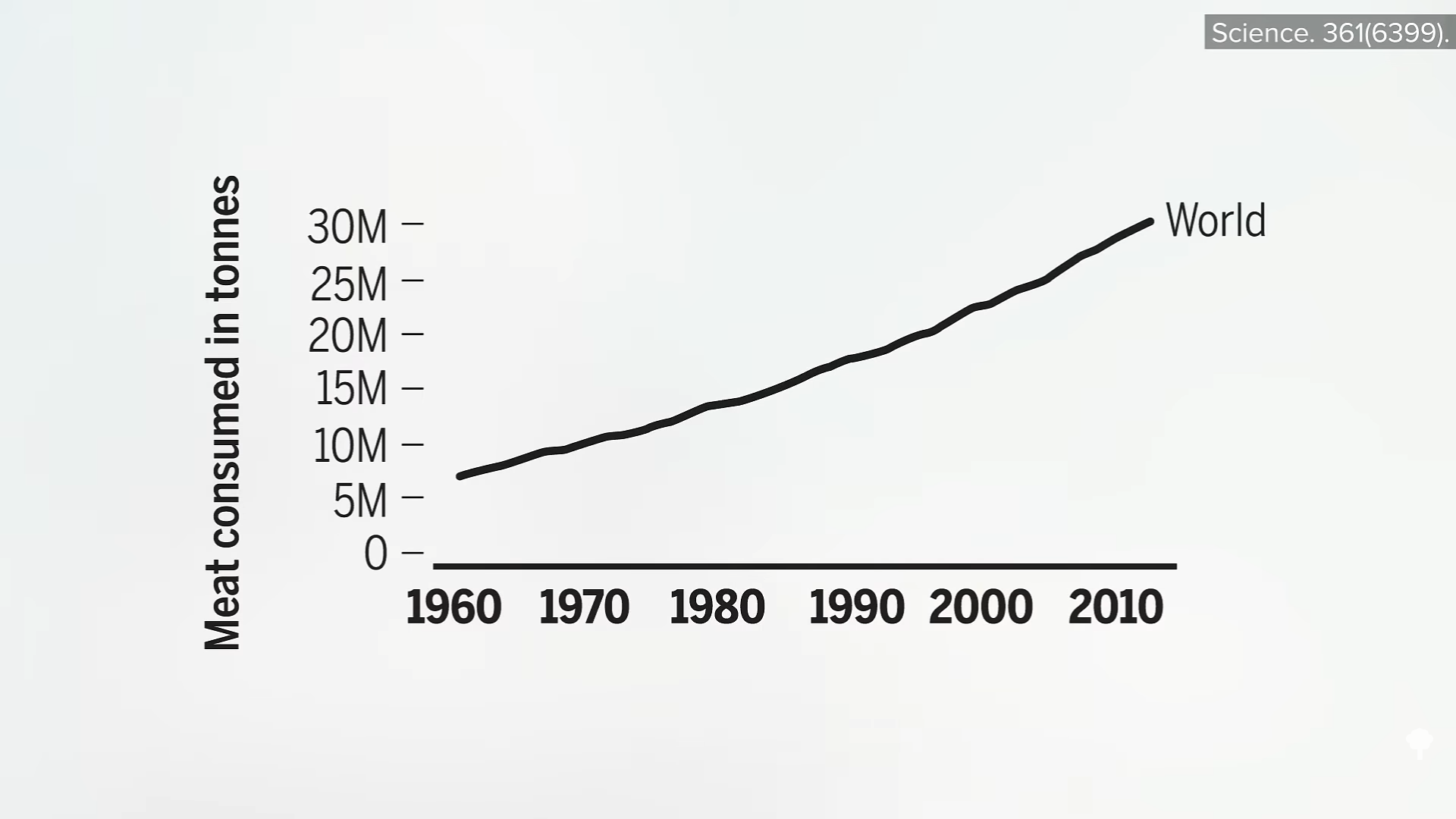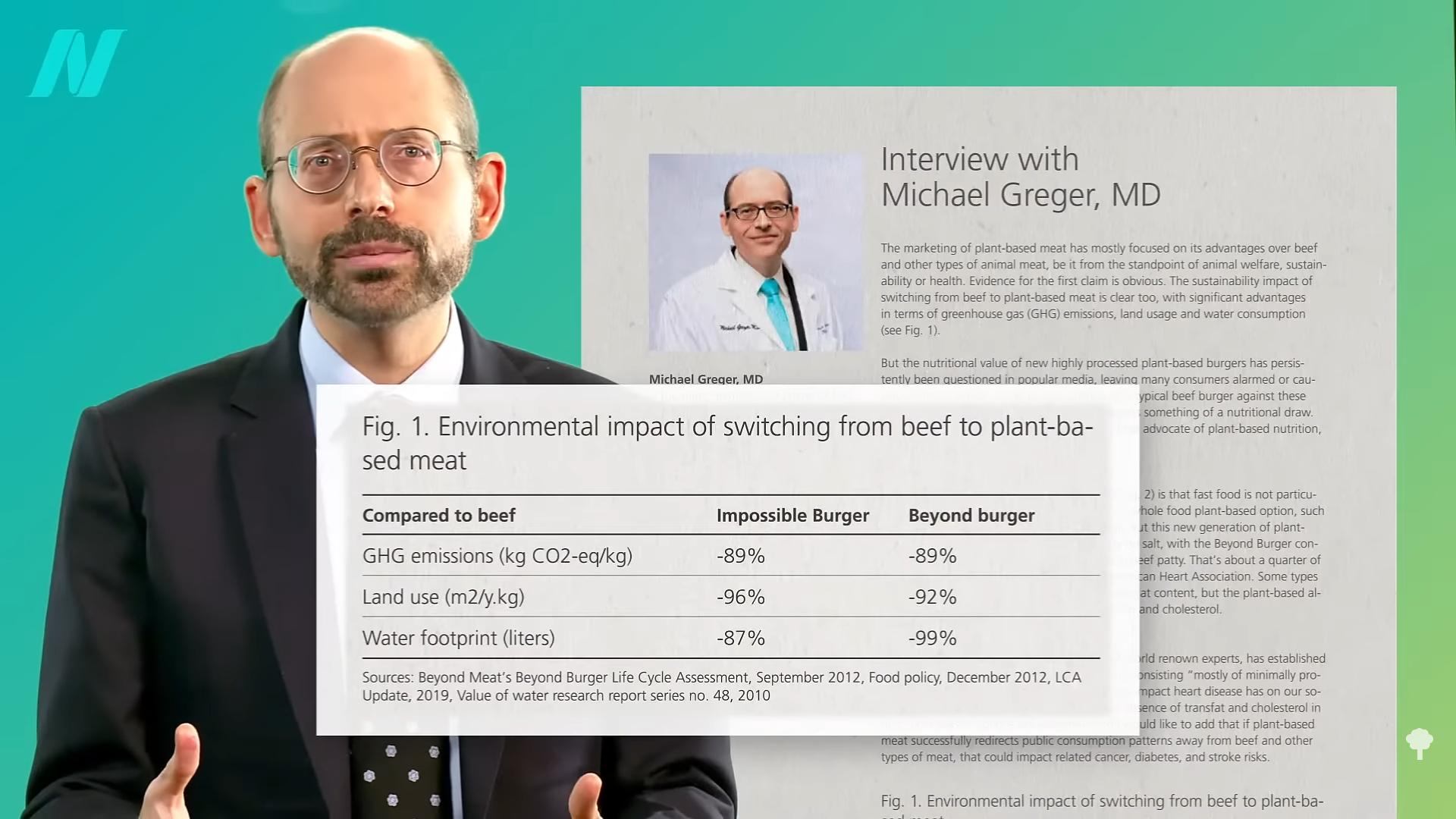Environmental assessments of 50 different plant-based meats show them to be vastly more sustainable than animal-based meats.
“There is increasing consensus that transitioning towards reduced meat consumption and more plant-based diets is a key feature to address important health and sustainability challenges” that humanity is facing, yet the graph below and at 0:25 in my video The Environmental Impacts of Plant-Based Meat Substitutes shows that the trajectory of global meat consumption has increased.

According to the Food and Agriculture Organization of the United Nations, “we will have to double the production of meat and dairy to meet the predicted demand for animal proteins in 2050.” However, we would have to do the exact opposite to contain the ecological damage and “environmental impact of livestock.”
“Nearly every credible forecast shows that if we’re to have any chance of meeting future food in a sustainable fashion, lowering our meat consumption will be absolutely essential.”
More centralized governments may be effective in influencing consumption patterns. For example, the “Chinese government has outlined a plan to reduce its citizens’ meat consumption by 50%,” but since the main drivers of global meat consumption are factors such as rising incomes, urbanization, and Western culture, the “main identified drivers of meat demand are difficult to influence through direct policy intervention.” Thus, we must take our case directly to the consumer. However, information and education may not be enough. We may need the “increased availability of ready-made plant-based products.”
Too often, alone, “ethics and sustainability does not stand much of a chance in a world of consumers…Many consumers seem deaf to ethical arguments…[that] are quickly forgotten when one is buying food.” When it comes to “consumers’ perceived barriers to following a plant-based diet,” the largest barrier may simply be “meat appreciation,” enjoying the taste of meat. So, in practice, if we want people to shift to plant-based options, “the taste, structure and nutritional value of vegetarian meals could be developed to more closely follow the preferences of meat eaters.” Why design a veggie burger primarily for vegetarians? They’re already not eating meat. When Patrick Brown founded Impossible Foods, “his goal was to create something a burger lover would say is better than any burger they’ve ever had.’” Also in the marketplace is “the Beyond Burger, created by Beyond Meat, a company founded to tackle climate change by creating vegan products free from meat and animal by-products” that are “Juicy, Meaty and Delicious.”
But are they better for the climate? If so, how much better? Reputable groups have published environmental lifecycle assessments covering the Impossible Burger and the Beyond Burger, and I did a short piece for the Swiss investment firm UBS summarizing the results, as you can see below and at 2:48 in my video.

Indeed, switching to either plant-based meat option, the Impossible Burger and the Beyond Burger reduce greenhouse gas emissions, land use, and water footprints by about 90 percent, compared to beef.
Similar lifecycle analyses have been performed on more than 50 different plant-based meats. All such studies found them to be vastly more sustainable than meat and processed meat products, with no real differences in greenhouse gas (GHG) emissions observed between the different sources of protein used in the plant-based meats, whether wheat, soy, or another. Though, obviously, any products containing eggs would be significantly worse with “significantly higher amounts of GHG.”
Now, of course, if we went straight to the unprocessed peas and soybeans from which the Beyond and Impossible Burgers are made, we wouldn’t get just a 90 percent lower environmental impact, but around a 99 percent lower impact. That impact drops to zero, however, if no one is willing to eat it.
A review of consumer research on meat alternatives found that although considerations like “health, environmental and animal welfare aspects can persuade consumers and influence their decision to try a meat substitute, the appearance, and taste of those meat substitutes are crucial factors for their consumption on a regular basis.”
Interestingly, these days, plant-based foods may actually have a leg up. Researchers gave omnivorous college students both animal- and plant-based chocolate milk, macaroni and cheese, chicken tenders, and meatballs, but told them they were actually all made from plants. The researchers “surprisingly and unexpectedly found that when subjects tasted the food and rated how much they liked the taste, those who were told the food was vegan liked the food significantly better than did those who were told the food was of animal origin. Thus, thinking a food was vegan actually increased liking for the taste of that food.”
Other demographics may have a different reaction, though, in which case there is always “sustainability-by-stealth,” using blended products that substitute some of the animal protein for plant protein. Recently, such “hybrid products (meat analogs in which part of the meat is replaced by plant-based ingredients) have made a promising entrance,” so much so that Perdue and Tyson, two major meat producers, are bragging about the incorporation of plant protein into their blended products, as you can see here and at 4:41 in my video.

This is from the first of nine videos in a series on plant-based meats, which includes the titles in the related posts below.
For background on food and climate change, see Diet and Climate Change: Cooking Up a Storm.
